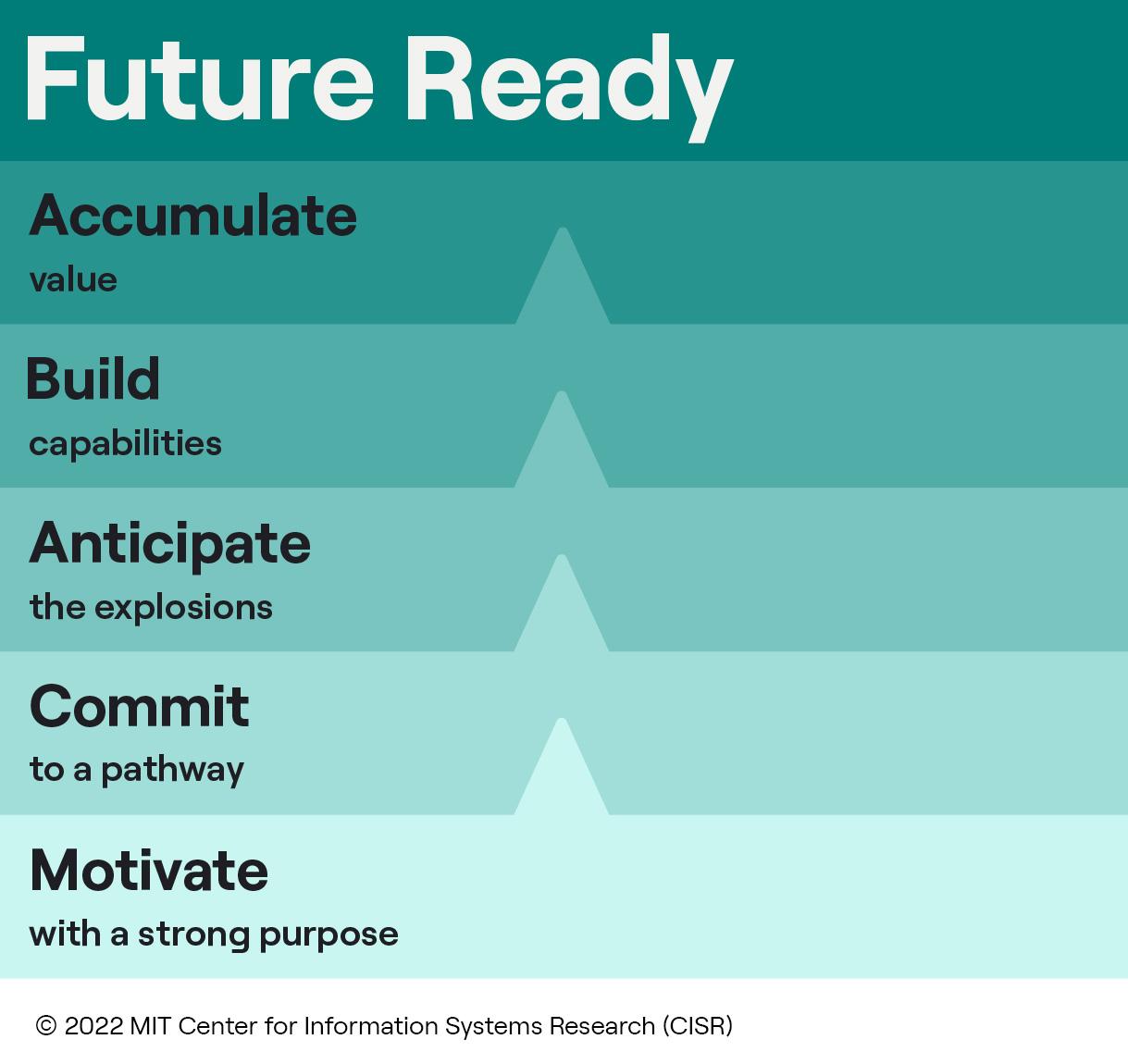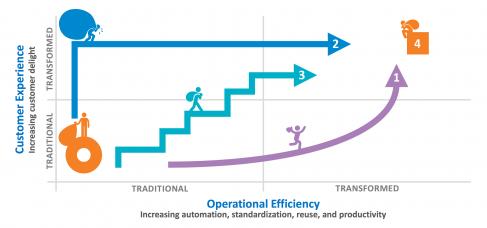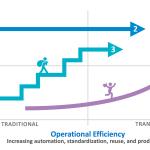Transforming a company to succeed in the digital economy requires a vision—and a playbook to help leaders deliver on that vision, communicate with markets, motivate employees, and keep everyone focused on a common goal as they work to create new value in an increasingly digital world. In our recently published book, Future Ready: The Four Pathways to Capturing Digital Value,[foot]Stephanie L. Woerner, Peter Weill, and Ina M. Sebastian, Future Ready: The Four Pathways to Capturing Digital Value (Boston, MA: Harvard Business Review Press, 2022), https://cisr-mit-edu.ezproxy.canberra.edu.au/publication/future-ready-four-pathways-capturing-digital-value. [/foot] which was based on more than five years of MIT CISR research,[foot]MIT CISR developed the book based on research from 2017 to 2022 that included over fifty interviews with executives and several surveys with a total of over 2,000 respondents. Findings were field-tested in multiple workshops with senior management teams and boards, presentations, and master classes.[/foot] we identified five actions comprising the journey that we recommend companies take to ensure their transformation to future ready is successful. These actions are a summary of what a company must get right in the transformation, and they help leaders prioritize their efforts. In this research briefing, we describe the five actions and illustrate them with a case study from CEMEX.

Five Actions Leaders Must Get Right to Get to Future Ready
Abstract
In our recently published book, Future Ready: The Four Pathways to Capturing Digital Value, we identified five actions comprising the journey that we recommend companies take to ensure their digitally enabled business transformation is successful. In this research briefing, we describe the five actions and illustrate them with a case study from CEMEX.
Managing a Digitally Enabled Business Transformation
Once leaders have a deep understanding of the competitive opportunities digital creates and a shared commitment to devote time and resources to the company’s transformation, they must begin the transformation journey by mapping out how they will take five actions (see figure 1):
- Motivate with a strong purpose. For a transformation to be meaningful and resonate with stakeholders, leaders must make the company’s purpose the journey’s North Star. Its purpose guides a company’s version of future ready, becomes the shared goal, and helps people make judgments about trade-offs in times of uncertainty.
- Commit to a pathway. Many companies beginning a transformation have a number of silos: sets of systems that support a subset of a company such as a business unit, a product, or a geography. Not compatible or not integrated, these silos must be connected point-to-point to enable each new solution, with the overall system ultimately resembling a plate of spaghetti. To move toward future ready from this state, every company must choose a pathway (or multiple coordinated pathways) for the transformation. Aligning on a common language for the transformation and then on the chosen pathway(s) is critical in preventing executives and other employees from talking past each other and executing an uncoordinated approach with poor outcomes.
- Anticipate the explosions. Companies must deal with difficult organizational changes—altering decision rights, creating new ways of working, developing a platform mindset, and performing organizational surgery—to develop new enterprise-wide capabilities for customer experience and operational efficiency. We call these changes organizational explosions because they are disruptive and affect most of a company’s employees and partners. Leaders need to address the explosions carefully, anticipating and managing their impacts, to create rather than destroy value.
- Build capabilities. Our research identified ten future-ready capabilities that top-performing companies develop to progress on customer experience and operational efficiency simultaneously and consistently and capture more digital value. Among the ten capabilities are facilitating rapid learning throughout the company and taking a modular, open, and agile approach to managing technology.[foot]S. L. Woerner, I. M. Sebastian, and P. Weill, “Develop Ten Capabilities to Accelerate Digital Transformation,” MIT CISR Research Briefing, Vol. XXII, No. 9, September 2022, https://cisr-mit-edu.ezproxy.canberra.edu.au/publication/2022_0901_TenCapabilities_WoernerSebastianWeill.[/foot] An important and far-reaching aspiration is to extend these ten future-ready capabilities across the entire company, including the board and top management team. This is an ongoing effort that requires leadership, budget, fresh approaches and new metrics, and perseverance.
- Accumulate value. To achieve future-ready company performance, leaders must ensure that digital transformation initiatives accumulate value from operations, from customers, and from ecosystems—all significant predictors of company performance[foot]I. M. Sebastian, P. Weill, and S. L. Woerner. “Three Types of Value Drive Performance in Digital Business,” MIT CISR Research Briefing, Vol. XXI, No. 3, March 2021, https://cisr-mit-edu.ezproxy.canberra.edu.au/publication/2021_0301_ValueinDigitalBusiness_SebastianWeillWoerner.[/foot]—ideally tracked in real-time dashboards. Dashboards should be accessible by everyone at the company, including the board and top management team, to make success visible and guide next steps.
Figure 1: The Journey to Future Ready
Leading the CEMEX Journey to Future Ready
Leaders at global building materials company CEMEX got the five actions right in its successful transformation to Future Ready.[foot]The case study on CEMEX draws from Woerner, Weill, and Sebastian, Future Ready: The Four Pathways to Capturing Digital Value, pp. 94-103.[/foot] In 2021 CEMEX, with more than 46,000 employees across four core businesses (cement, ready-mix concrete, aggregates, and urbanization solutions), had net revenues of $14.5 billion (up 14 percent from 2020), a net profit margin (TTM) of 9.7 percent, and sector-leading customer satisfaction.[foot]Details except for net profit margin from CEMEX, 2021 Integrated Report, “Building a Better Future,” March 24, 2022, from the CEMEX website, https://www.cemex.com/documents/20143/57102208/IntegratedReport2021.pdf/ca7f90b7-d742-314c-de70-7de4bf8f5431?t=1648173083550?download=true. CEMEX net profit margin (TTM) is from Cemex, S.A.B. de C.V., Company Summary, D&B Hoovers, retrieved September 2, 2022.[/foot]
CEMEX spent considerable time in the early 2000s improving its operations to gain global efficiencies through process standardization (which the company called the CEMEX Way) and building a strong reputation for quality, safety, and materials innovation. In 2014 the company’s top management team initiated a digital business transformation with a focus on delivering a superior customer experience enabled by digital technologies, as customers were increasingly expecting to have the same experiences when working with businesses digitally that they had in the consumer space.
CEMEX leaders motivated efforts on the digital business transformation by recognizing it as a new frontier for achieving the company’s purpose: “to make the future better for our customers, our shareholders, and our communities by becoming the world’s most efficient and innovative building materials company.”[foot]“Our History,” About Us, CEMEX, https://www.cemex.com/about-us/our-history.[/foot] The top management team recited this customer experience mantra repeatedly when engaging investors, customers, employees, and industry partners. CEMEX CEO Francisco Gonzalez initially led the digital business transformation with three heads of digital; he then established shared ownership of the transformation by the executive committee.
CEMEX’s senior leadership team committed to a transformation on Pathway 2.[foot]MIT CISR research identified four distinct pathways to become future ready; a transformation on Pathway 2 first improves customer experience and then increases operational efficiency. All four pathways are described in P. Weill and S. L. Woerner, “Future Ready? Pick Your Pathway for Digital Business Transformation,” MIT CISR Research Briefing, Vol. XVII, No. 9, September 2017, https://cisr-mit-edu.ezproxy.canberra.edu.au/publication/2017_0901_DigitalPathways_WeillWoerner. [/foot] The team designed the transformation in two phases: the first phase focused on upgrading the customer experience by creating the digital platform and an omnichannel experience; and the second phase focused on enhancing operational efficiency and reducing cost to serve while continuing to improve customer experience. Executive education and workshops helped the team align on a common language to guide customer-facing efforts in developing the CEMEX Go platform, which the company launched in 2017. CEO Gonzalez and the executive team anticipated the explosions and pursued efforts to manage them, including creating a process for the transformation, connecting IT and the business, naming CEMEX Go the institutional platform for the digital transformation in the commercial space, and establishing agile teams to develop platform services. To guide employees regarding the resulting cultural changes, they defined a “digital mindset” with five components: (1) a focus on customer centricity and customer journeys, (2) iterative (time-boxed) work processes, (3) collaborative work habits that transcend silos and hierarchies, (4) test and learn environments that foster experimentation, and (5) embracing continuous change.
Supported by its purpose, commitment, and management of the explosions, CEMEX built future-ready capabilities such as becoming modular, open, and agile.[foot]Woerner, Sebastian, and Weill, “Develop Ten Capabilities to Accelerate Digital Transformation.”[/foot] CEMEX’s breakthrough initiative CEMEX Go, for which deployment completed in 2019, facilitated the full digital customer journey: discovering CEMEX, becoming a customer, placing an order, receiving products, receiving invoices, and receiving support. To enable this experience, an important part of the first phase of the transformation was integrating CEMEX Go with new systems for order fulfillment and customer relationship management to replace the previously manually assisted back-end processes behind the customer interface. The integration enabled a new digital confirmation capability: an automatic review of inventory, transport, and other components of the customer journey when an order is confirmed online. In the second phase, CEMEX reduced complexity and cost to serve by progressing this capability to create two new platforms to complement CEMEX Go: SmartOps, for production; and Working Smarter, to optimize management systems for employees. By 2022, CEMEX had automated order fulfillment for its cement product, and was developing capabilities for artificial intelligence and machine learning to automate the more complex coordination process for delivering its ready-mix concrete product, making the digital confirmation capability available across the organization.
CEMEX quickly accumulated value from customers as the company developed its customer-facing CEMEX Go platform and scaled it worldwide. Customers referred to CEMEX Go as a “one-stop shop,” a platform that allowed them to seamlessly place, schedule, or adjust an order; receive instant notifications regarding their order; track delivery trucks in real time; and manage invoices and payments from multiple devices. By 2020, fifty-two percent of CEMEX’s global sales were processed through CEMEX Go, and about ninety percent of recurring customers used the service.[foot]CEMEX, Third Quarter 2020 Results, presentation, October 28, 2020, p. 10, from the CEMEX website, https://www.cemex.com/documents/20143/49897099/3Q20results_English.pdf/b53e9747-672f-59fb-f8e8-a26342e32132.[/foot] The company saw its highest-ever global Net Promoter Score (NPS) of 67 in the second quarter of 2020,[foot]CEMEX, Second Quarter 2020 Results, presentation, July 27, 2020, p. 4, from the CEMEX website, https://www.cemex.com/documents/20143/49897099/2Q20results_English.pdf/42519285-1974-b582-c96c-8e6e455831d7.[/foot] an increase from 50 in 2019 and 44 in 2018.[foot]CEMEX, Integrated Report 2019, “Building for a Better World,” March 26, 2020, p. 211, from the CEMEX website, https://www.cemex.com/documents/20143/49694544/IntegratedReport2019.pdf/4e1b2519-b75f-e61a-7cce-2a2f2f6f09dc.[/foot]
In the second phase of its transformation, with a focus on operational efficiencies and the addition of digital business models aimed at growth, CEMEX has increasingly accumulated value from operations—by reducing cost to serve—and value from ecosystems. For example, CEMEX licenses the CEMEX Go platform to other companies in the construction industry, and the company created Arkik, a startup to commercialize the ready-mix management system as a service for CEMEX’s independent ready-mix customers who can connect with CEMEX Go’s order fulfillment to improve their own operations.
Learning on the Journey Is Key to a Successful Transformation
When they get the five actions right, leaders initiate and sustain a profound organizational transformation and culture change to become Future Ready. To ensure leaders manage change well, we recommend creating a learning organization by making progress visible throughout the company with real-time dashboards[foot]P. Weill and S. L. Woerner, “Dashboarding Pays Off,” MIT CISR Research Briefing, Vol. XXII, No. 1, January 2022, https://cisr-mit-edu.ezproxy.canberra.edu.au/publication/2022_0101_Dashboarding_WeillWoerner.[/foot] and monitoring the employee experience to ensure employees can adjust to and thrive amidst changes,[foot]N. van der Meulen and K. Dery, “The Employee Experience of Digital Business Transformation,” MIT CISR Research Briefing, Vol. XX. No. 1, January 2020, https://cisr-mit-edu.ezproxy.canberra.edu.au/publication/2020_0101_PathwaysEX_MeulenDery.[/foot] then iterating these actions to become best practices.
© 2022 MIT Sloan Center for Information Systems Research, Sebastian, Woerner, and Weill. MIT CISR Research Briefings are published monthly to update the center’s patrons and sponsors on current research projects.
About the Authors
MIT CENTER FOR INFORMATION SYSTEMS RESEARCH (CISR)
Founded in 1974 and grounded in MIT's tradition of combining academic knowledge and practical purpose, MIT CISR helps executives meet the challenge of leading increasingly digital and data-driven organizations. We work directly with digital leaders, executives, and boards to develop our insights. Our consortium forms a global community that comprises more than seventy-five organizations.
MIT CISR Associate Members
MIT CISR wishes to thank all of our associate members for their support and contributions.











